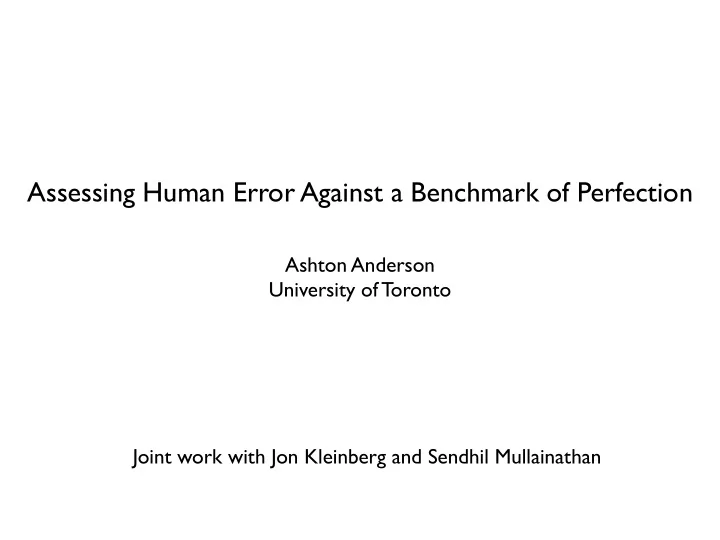

Assessing Human Error Against a Benchmark of Perfection Ashton Anderson University of Toronto Joint work with Jon Kleinberg and Sendhil Mullainathan
Humans and Machines One leading narrative for AI: humans versus machines For any given domain, when will algorithms exceed expert-level human performance?
Humans and Machines A set of questions around human/AI interaction: • Relative performance of humans and algorithms • Algorithms as lenses on human decision-making • Humans and algorithms working together: pathways for introducing algorithms into complex human systems Can we use algorithms to characterise and predict human error?
Chess for Decision-Making Long-standing model system for decision-making • “The drosophila of artificial intelligence.” —John McCarthy, 1960 • “The drosophila of psychology.” —Herb Simon and William Chase, 1973 Chess provides data on a sequence of cognitively difficult tasks. When a human player chooses a move, we have data on: • The task instance: the chess position itself. • The skill of the decision-maker: a chess player’s Elo rating. • The time available to make the decision. Can we use computation to analyze human performance? • Characterize human “blunders” (mistakes in choice of move) • Chess as the drosophila of machine superintelligence?
A History of Chess Engines • 1988: First recorded win by computer against human grandmaster under standard tournament conditions. • 1997: Deep Blue defeats world champion Kasparov in 6-game match. • 2002–2003: Draws against world champions using desktop computers. • 2005: Last recorded win by a human player against a full-strength desktop computer engine under standard tournament conditions. • 2007: Computers defeat several top players with “pawn odds.”
Chess for Decision-Making Could use chess engines to evaluate moves [Biswas-Regan 2015] • Promising, since engines are vastly superior to the world’s best players • Engines sometimes detect clear-cut errors, but very often a “grey area”: engines and humans disagree, but doesn’t necessarily change the outcome of the game
Chess for Decision-Making We use the fact that chess has been solved for positions with at most 7 pieces on the board. • “Tablebases” record all possible positions with <=7 pieces • Can determine (game-theoretic) blunders by table look-up • These positions are still difficult for even the world’s best players The Stiller moves are awesome, almost scary, because you know they are the truth, God’s Algorithm; it’s like being revealed the Meaning of Life, but you don’t understand one word. — Tim Krabbé, commenting on an early tablebase by Lewis Stiller
Chess for Decision-Making Data from two sources: # Games Rating Duration Setting Casual enthusiasts FICS 200M 1200–1800 Minutes playing online Professional GM 1M 2400–2800 Hours tournaments Take all <7-piece positions, classify a move as a blunder if and only if it changes the win/loss/draw outcome
Basic Dependence on Fundamental Dimensions How does decision quality vary with { skill time ? difficulty
Human Error as a Function of Skill • 1000: Winner of a local scholastic contest • 2300: Lowest international title • 1600: Competent amateur • 2500: Grandmaster • 2000: Top 1 % of players • 2850: Current world champion
Human Error as a Function of Time
Human Error as a Function of Time
Human Error as a Function of Difficulty A simple measure for the difficulty of a position: the “blunder potential” is the probability of blundering if you choose a move at random Blunder potential = 9 / 18 = 0.5
Human Error as a Function of Difficulty Simple, quantal-response model captures how error varies with difficulty: a particular non-blunder is c times more likely than a particular blunder
Blunder Prediction Use fundamental dimensions to predict: will the player blunder in a given instance? • The difficulty of the position • The skill of the decision-maker (Elo rating) • The time remaining • A set of features encoding difficulty deeper in the game tree Performance using decision-tree algorithms: • All features: 75% • Blunder potential alone: 73% • Elo of player and opponent: 54% • Time remaining: 52%
Human Error as a Function of Skill
Human Error as a Function of Skill Difficulty is the dominant feature To the extent this is surprising, connections with fundamental attribution error, and Abelson’s Paradox [Abelson 1985]
Human Error as a Function of Skill Fix blunder potential: higher-depth blunder potential is the dominant feature. Fix the exact position: skill and time become predictive. Difficulty is dominant on average. Is this true point-wise? • For position p , examine blunder rate as a function of skill in p • Call a position skill-monotone if blunder rate is decreasing in r • Natural conjecture: all positions are skill-monotone
Fixing the position Difficulty is dominant on average. Is this true point-wise? • For position p , examine blunder rate as a function of skill in p • Call a position skill-monotone if blunder rate is decreasing in r • Natural conjecture: all positions are skill-monotone In fact, we observe a wide variation, including skill-anomalous positions Connections with U-shaped development
Challenges arising from misleading analogies?
Number of occurrences
Reflections on Teaching Contrast: Traditional organization in textbooks Adding information about frequency and rate
Reflections on Teaching High-level goal: create a human-like AI Understand and model human decision-making qualities at various levels Can we build an algorithmic teacher from large-scale data on human decisions?
Reflections Framework for analyzing human error given large numbers of similarly structured instances. Compare human performance to computational benchmark (in this case a perfect one) In chess, difficulty is the dominant predictor of human error Similar for other domains? Opportunities for rich understanding of human decision-making using algorithms
Recommend
More recommend